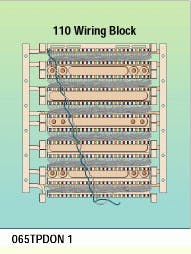Don Essig, Mahon Communications Corp.
Problem
In today`s telecommunications installations, high-count twisted-pair cable is becoming more common in main crossconnect and intermediate crossconnect designs. As a result, 100-pair, 300-pair and higher pair counts are common for main and sub-feeds. These high-count cables generally contain color-coded binders that identify individual 25-pair bundles. Sometimes these binders can be misrouted to their respective positions on the block when they are punched down. In addition, binders can be mistakenly cut off if the cable is not correctly broken out. Having to remove and reterminate bundles that are not cut down properly is time-consuming and frustrating. In addition, you may not have enough slack to re-route these bundles.
Solution
Although this may seem unnecessary to an experienced technician, testing high-count twisted-pair cable can be accomplished by consecutively cutting down a cross wire on each bundle. This will work for 600 twisted-pair cables at a time. The procedure usually takes approximately 20 minutes.
Procedure
1) After breaking out and cutting down one end of the cable, inject tone through each 25-pair cable with a tone generator and a single-pair cross wire.
2) Cut down on the first pair of your first 25-pair bundle with the dull side of your impact blade. This will prevent cutting the cross wire. Then go to the second pair of the second bundle, the third pair of the third bundle, and so on, until all 25-pair bundles are cross-wired.
3) Go to the opposite end of your cable with an inductive amplifier wand and look for the tone. If all the bundles are laced through the block field correctly, the tone should travel down this field in the exact order in which you cut down your test cross wire.
4) If not, you have bundles out of order. Re-route the unterminated bundles to where they belong.
On a 110 wiring block, you can test to 600 twisted-pair cables at one time without using the same 25-pair bundle twice.

